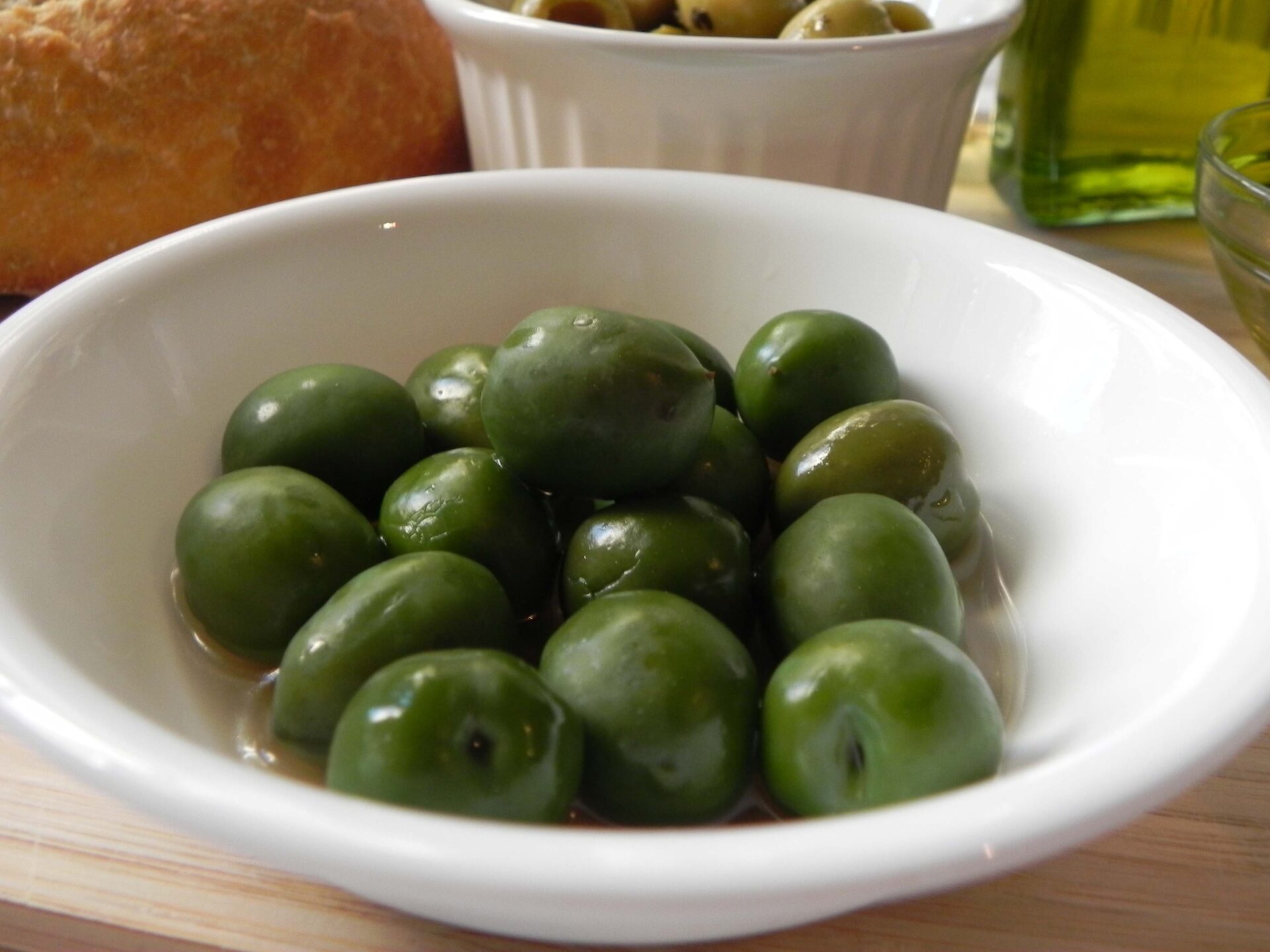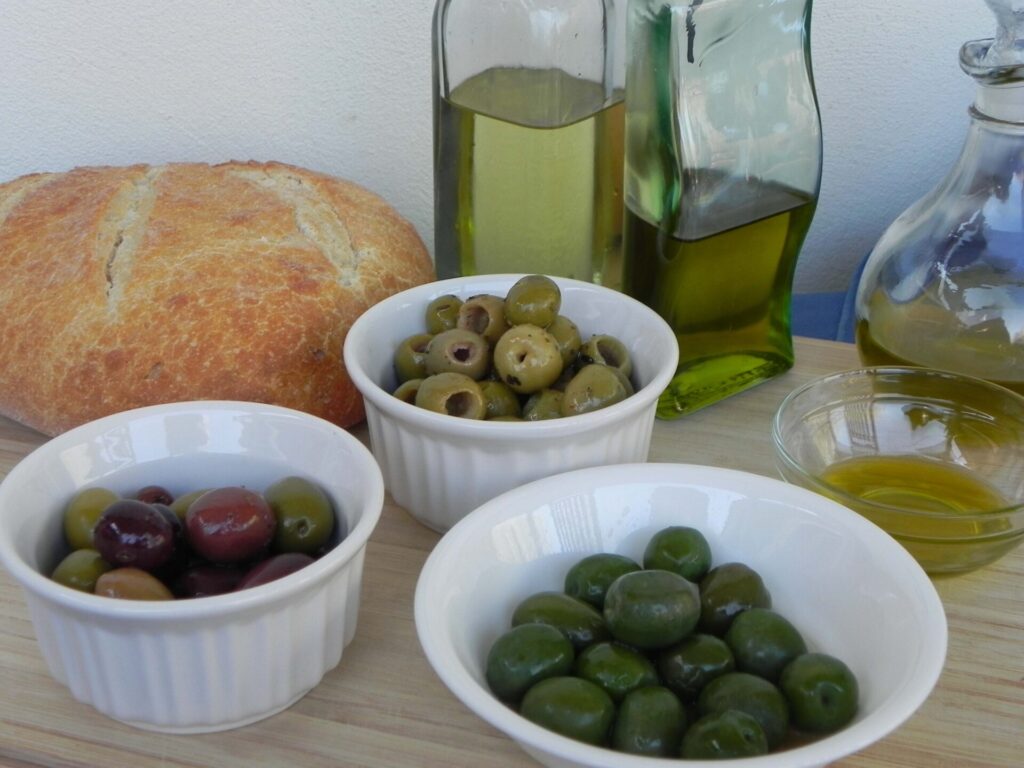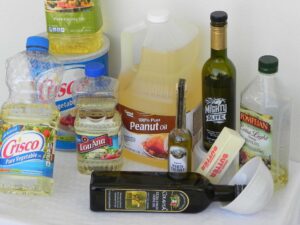
By Laurie Triplette
ldtriplette@aol.com
In this four-part series, food writer Laurie Triplette will focus on demystifying olive oil, which has been a darling of the American food world for years. Triplette claims that the world of olive oil contains as many mysteries as most Southern families hide in our gene pools. The author thanks Dr. Kathy Knight, Associate Professor and Interim Chair of the University of Mississippi Department of Nutrition and Hospitality Management, for fact-checking support on Part 3 of this series.
Click on the following links to catch up on the series: Part 1, Part 2, Part 3, and Part 4.
PART 3: IS OLIVE OIL REALLY GOOD FOR US?
Olive oil is a fundamental component of the Mediterranean Diet that has become popular in recent years. For years proponents have claimed that olive oil contains almost miraculous restorative or curative powers because it is rich in polyphenols. Polyphenols have antioxidant characteristics that have been proven to reduce risk of cardiovascular disease and cancer.
However, olive oil is a fat, and like all fats, experts agree, too much is not a good thing. Detractors point out that all plant foods are rich in polyphenols and many provide more polyphenols than olive oil. Example: 5 tablespoons of olive oil provide 150 mg of polyphenols, but also deliver 600 calories; 55 calories of lettuce provide the same polyphenols.
 A number of studies into the health benefits of olive oil have provided data that on one hand can support the idea that it reduces bad LDL in our cholesterol. But on the other hand, according to some, those were “bad” studies, and the reduction of LDL actually might be more attributable to elimination of saturated animal fats more than to introduction of olive oil.
A number of studies into the health benefits of olive oil have provided data that on one hand can support the idea that it reduces bad LDL in our cholesterol. But on the other hand, according to some, those were “bad” studies, and the reduction of LDL actually might be more attributable to elimination of saturated animal fats more than to introduction of olive oil.
No two olive oils are the same, either. Lower grade, heavily refined, or old olive oils have lost the beneficial components such as polyphenols and vitamins. Only unadulterated EXTRA VIRGIN OLIVE OIL (EVOO) can be said to contain the components that reduce inflammation, lowers blood pressure, and help to decrease bad cholesterol (LDL).
The extra virgin grade of oil contains a cocktail of different fatty acids whose proportions change according to growing conditions such as climate, type of cultivar, amount of water received during the growing season.
All fats contain about 9 calories per gram compared to 4 calories for protein and carbs. Olive oils all contain about 13 grams of fat per tablespoon; this equals about 120 calories. Some aficionados recommend consuming 2 tablespoons of olive oil daily to reap the benefits of the polyphenols.
That’s a lot of calories. But the body needs a certain amount of dietary fats, because along with protein and carbohydrates, they provide energy to the body.
Fats help in the body’s absorption of vitamins A, D, E and K, all of which are crucial to health. Dietary fats add flavor to foods, and make us feel full or satisfied from hunger. Fat provides linoleic acid, which is essential for growth, healthy skin and a good metabolism.
 Just as there’s a good side to dietary fats, there’s a flip side. There are bad fats and not-so-bad, or even good, fats.
Just as there’s a good side to dietary fats, there’s a flip side. There are bad fats and not-so-bad, or even good, fats.
Consuming too much of the wrong type of dietary fats can negatively affect cardiovascular health, blood sugar levels and insulin sensitivity. We need several different kinds of fats in our diets, including cholesterol, but our bodies can make all the rest. Beneficial mega-3 and omega-6 fats are found in monounsaturated fats such as olive oil.
As with all foods, balance and moderation in fat consumption are key to good health.
Here’s a rundown on different types of fats:
Saturated fats: Are found in animal products, dairy foods, and tropical oils such as coconut and palm oils and cocoa butter. Saturated fats raise blood cholesterol levels and low-density lipoprotein cholesterol levels (LDL’s), which can adversely affect cardiovascular health and blood sugar levels. A healthy diet should contain less than 10 percent of its daily calories from saturated fats.
Trans fats: Partially hydrogenated fatty acids, sometimes found in fats such as margarine and shortening; they can raise low-density lipoprotein cholesterol levels (LDL’s) and lower high-density lipoprotein levels (HDL’s), which can affect cardiovascular health. Trans fats are abundant in processed foods and generally are thought to be bad fats.
Monounsaturated fats: Olive oil contains monounsaturated omega-9 fatty acids; monounsaturated fats are liquid at room temperature and might benefit insulin levels and blood sugar control, and are thought by some experts to lower LDL’s.
Polyunsaturated fats: Polyunsaturated omega-3 fatty acids are found in fatty fish such as salmon and walnuts, and in certain plants such as corn, soy, and safflower and the oils created from their seeds. Some decrease the risk of coronary artery disease, and might lower blood pressure and protect against irregular heartbeats.
All oils and fats contain some saturated fats as well as unsaturated fats. Olive oil contains about 75 percent of its fat in the form of oleic acid (a monounsaturated omega-9 fatty acid). It compares favorably to seed oils such as canola oil and corn oil, each with about 60 percent, soybean oil with 50-55 percent, sunflower oil with about 20 percent, and safflower oil with about 15 percent. ALL oils containing monounsaturated fats are more beneficial than highly saturated animal fats such as lard and butter.
In a sample of 100 grams of extra virgin olive oil (equivalent to about 7 to 8 tablespoons) one would find the following percentages of the recommended daily amounts (RDA):
Saturated fat: 13.8 percent
Monounsaturated fat: 73 percent
Omega-6: 9.7 percent
Omega-3: 0.76 percent
Vitamin E: 72 percent
Vitamin K: 75 percent
A series of recent studies have produced dramatic information about WHY olive oil is so beneficial.
Fresh high quality olive oil helps protect the body against inflammation because of the concentration of phytonutrients in the oil, particularly polyphenols. More than 100 polyphenols, hydrocarbons, vitamins (such as E) and other volatile compounds occur naturally in high quality olive oil.
One of the main polyphenols in olive oil is hydroxytyrosol (called HT), which inhibits nitrous oxide (NO) and prostaglandin E2, both of which are pro-inflammatory compounds. HT triggers changes at a genetic level, helping our blood vessel cells to embrace this antioxidant defense system.
Another of the molecules, labeled oleocanthal by researchers at the Monell Chemical Senses Center in Philadelphia, acts like Ibuprofin in inhibiting certain enzymes that cause inflammation and also may reduce the adverse effects of highly toxic protein byproducts called ADDLs (which are believed to contribute to Alzheimer’s onset).
Researchers have found that patients with diets low in monounsaturated fats benefit their cardiovascular health by increasing their dietary intake of monounsaturated fats. The results are dramatic — a decrease in blood cholesterol LDL cholesterol, and LDL:HDL ratio. (Remember, HDL is the good cholesterol, while LDL is the bad cholesterol.)
Olive oil monounsaturated fatty acids have been linked to decreased blood pressure as well. The polyphenols reduce the clotting action of red blood cells.
Scientists have concluded to date that it’s the oleic acid in olive oil that gets absorbed in our blood and migrates to the cell membranes, changing their signaling patterns. Those same substances that give really high quality olive oil its characteristic pepperiness, bitterness, and astringency, are directly proportional to the healthful properties of the oil.
The best olive oils are definitely an acquired taste.
In addition, experts have been pushing to understand the relationship between olive oil and cancer prevention. Researchers at the Mario Negri Institute for Pharmacological Research in Milan, Italy, have analyzed 25 different studies of olive oil and cancer risk, and established that there is a risk reduction impact of olive oil consumption on cancers of breast, upper and lower digestive tracts, and the respiratory tract.
The jury’s still out on why olive oil seems to help prevent rheumatoid arthritis. But olive oil has been proven to boost calcium absorption, which improves bone mineralization and calcification, reducing or preventing the onset of osteoporosis.
To reap the health benefits, we should consume fresh premium extra virgin and extra virgin olive oils, but not in large quantities. Spanish researchers conducted a study in 2004 that revealed many of olive oil’s healing properties vanished within 12 months, especially the vitamin E, chlorophyll, and beta-carotene, and even the phenols.
What about cooking with olive oils? Some experts caution that heating olive oils will oxidize their fatty acids and ruin the oil’s health benefits. But most cooks don’t intend to heat any oil to the over-the-edge smoke point. And cooks have been sautéing, frying, baking and braising with olive oils for eons.
The key to retaining benefits when using olive oils for cooking is to cook quickly and at lower temperatures.
Next: PART 4: Where Do We Find the Good Stuff?
[box style=”0″]
THE OLD BRIDE’S GUIDE TO DIFFERENT TYPES OF COOKING OILS
 The author has extracted the definitions from various sources (see Partial Bibliography below). For an approximate breakdown of comparative nutritional compositions and benefits, click here.
The author has extracted the definitions from various sources (see Partial Bibliography below). For an approximate breakdown of comparative nutritional compositions and benefits, click here.
Canola: Created by conventional plant breeding of a traditional wild rapeseed plant to reduce the content of erucic acid (a known toxin). Canola oil is created by slightly heating and crushing the seeds, refining the oil with hexane, bleaching and deodorizing the oil. It is a key ingredient in many foods, and is high in oleic and linoleic fatty acids. It is the third most widely consumed vegetable oil in the world, and genetically modified varieties have been controversial.
Coconut: Pure virgin coconut oil (not hydrogenated) contains 92 percent saturated fat. It contains a blend of fatty acids such as lauric acid, that in combination may offer some health benefits, including raising good HDL cholesterol levels, improving thyroid function, and fighting off viruses and bacterial infections, in addition to yeast, fungus and candida.
Corn: Oil extracted from the germ of corn kernels usually expeller pressed, then solvent-extracted using hexane or 2-methylpentane, solvents that have controversial impacts on the environment, and further refined to remove the free fatty acids.
Cottonseed: Is made by hulling and extracting the germ from the seed, with extensive refining, bleaching and deodorizing to eliminate the naturally occurring toxin gossypol (also present in okra). The oil contains about 70 percent unsaturated fatty acids (18 percent monounsaturated and 52 percent polyunsaturated), but when hydrogenated, contains about 94 percent saturated fats. The original oil used to create a substitute for animal fats such as lard (think Crisco and Wesson oil), cottonseed oil has been reformulated in the 21st century to reduce the trans fats contained in the hydrogenated version. It has been a mainstay in processed foods, although use has diminished due to the high cost of cotton production. The U.S. Code of Federal Regulations contains regulations governing the amount of crop pesticide allowed in cottonseed used for food oil.
Flax (flaxseed or linseed): Is heavily promoted as an alternative to fish oil; food-grade flaxseed oil is cold pressed and obtained without using solvents. Fresh, unprocessed flax oil must be refrigerated because it turns rancid quickly due to oxidation. Even refrigerated, its shelf life is only a few weeks. Flax oil has a robust flavor and is a favorite ethnic food supplement in Europe, containing the highest level of omega-3 fatty acid ALA of all vegetable oils.
Grape seed: Is pressed from the seeds of grapes, and has a clean and light taste that make it desirable for use in salad dressings and mayonnaise. It is low in saturated fats and has a relatively high smoke point, making it good for use in baking.
Hempseed: The food-use version of this oil is cold pressed and unrefined, and is not to be confused with hash oil made from the cannabis flower (which contains THC). Hemp oil contains a desirable 3:1 ratio of omega-6 to mega-3 essential fatty acids matching the balance required by the human body.
Olive oil: The oil obtained by cold pressing the olive fruit and extracting the oil from the juice through various methods. Graded for nutritional value according to fatty acids contents and degree of refinement, olive oil is generally considered the most desirable of vegetable oils.
Palm: This edible vegetable oil comes from the mesocarp (pulp) of the fruit of African oil palms, American oil palms, and the maripa palm, and should not be confused with palm kernel oil, which comes from the kernel of the oil palms’ fruit, or with coconut oil. It is naturally high in saturated fatty acids and is solid at room temperature. Although popular in some cultures, it is not recommended for daily use and has been cited as having negative environmental impact.
Peanut: Also known as groundnut or arachis oil, is a mild-tasting vegetable oil compressed from peanuts. Most highly refined versions have removed the allergens, but cold pressed oils have not. Its high smoke point make it desirable for frying foods, and it is composed mostly of oleic, linoleic, and palmitic fatty acids.
Safflower: Vegetable oil extracted from seeds of the safflower, a herbaceous thistle-like annual plant; one of the oldest cultivated crops for the seeds and flowers used as oils and as yellow and red dyes (an d the red flowers as a cheap substitute for saffron). Two types of safflower produce different oils: one the monounsaturated fatty oleic acid (lower in saturates than olive oil), and the other polyunsaturated fatty linoleic acid.
Sesame: Known as the queen of oils, it is rich in oleic and linoleic acids, with a high proportion of omega-6 fatty acid, but keeps well at room temperature, unlike many oils containing this much. It has been used for thousands of years, but is expensive to produce.
Soybean: This oil is composed primarily of polyunsaturated fats, with lesser, but almost equivalent percentages of saturated and monounsaturated fats. It is created by cracking, heating and rolling the beans, and extracting the oil with hexanes. Further refining results in both liquid and partially hydrogenated vegetable oils that are used as an ingredient in many processed foods. The high percentage of linoleic acid makes it less than desirable for use in frying.
Sunflower: A non-volatile oil that is a mixture of monounsaturated AND polyunsaturated oleic (omega-9) and linoleic (omega 9) oils compressed from seeds of the sunflower, used both for frying foods and as an emollient in cosmetics. It is high in vitamin E and low in saturated fats. Recently criticized for containing too many omega-6 fats (as much as 70%), causing inflammation.
Vegetable: Actually is a blend of several oils, including soybean oil, corn oil, cottonseed oil, palm and sunflower oil. Consumers with food allergies know to stay away.
Walnut: Extracted from English walnuts, this is a high-priced oil with delicate scent and nutty flavor, most used for enhancing cold dishes. It is high in polyunsaturated fatty acids and is not recommended for heat-cooking.
[/box]
Laurie Triplette is a writer, historian, and accredited appraiser of fine arts, dedicated to preserving Southern culture and foodways. Author of the award-winning community family cookbook GIMME SOME SUGAR, DARLIN’, and editor of ZEBRA TALES (Tailgating Recipes from the Ladies of the NFLRA), Triplette is a member of the Association of Food Journalists (AFJ), Southern Foodways Alliance (SFA) and the Southern Food and Beverage Museum (SOFAB). Check out the GIMME SOME SUGAR, DARLIN’ web site: www.tripleheartpress.com and follow Laurie’s food adventures on Facebook and Twitter (@LaurieTriplette).
_______________________________
OLIVE OIL PARTIAL BIBLIOGRAPHY
Alleman, Gayle. TLC (The Learning Channel); https://recipes.howstuffworks.com/how-olive-oil-works2.htm)
Braslow, Carol. Interviews, March 11 and April 15, 2014. The Mighty Olive, Memphis, TN.
Braslow, Samuel. Interview March 11, 2014; The Mighty Olive, Memphis, TN; and correspondence, April 12, 2014.
Flynn, Mary PhD, R.D. article: https://www.truthinoliveoil.com/2013/04/truth-on-olive-oil-health
Fuhrman, Talia, 01/30/12, essay in The Official Blog of Joel Fuhrman, MD; https://www.diseaseproof.com/archives/hurtful-food-its-about-time-the-olive-oil-myth-was-laid-to-rest.html
Gunnars, Kris, sports nutrition web blog: March 23, 2014, essay: https://authoritynutrition.com/extra-virgin-olive-oil/; May 11, 2013, essay: https://authoritynutrition.com/healthy-cooking-oils/
Hensrud, Dr. Donald, MD. https://www.mayoclinic.org/healthy-living/nutrition-and-healthy-eating/expert-answers/food-and-nutrition/faq-20058439
Kalua, C.M., Allen, M.S., Bedgood Jr., D.R., Bishop, A.G., Prenzler, P.D., Robards, K.“Olive Oil Volatile Compounds, Flavour Development and Quality: A Critical Review,” Journal of Agriculture and Food Chemistry; Wagga Wagga, Australia: Graham Centre for Agricultural Innovation; Charles Sturi University; September 20, 2005.
Knight, Kathy, PhD, RD. Interim Director, Department of Food and Hospitality Services, University of Mississippi. Oxford, MS.
Mueller, Tom. Extra Virginity. The Sublime and Scandalous World of Olive Oil. New York, NY: W.W. Norton & Company, 2012.
Mueller, Tom. Truth in Olive Oil web site: https://www.truthinoliveoil.com/about-truth-olive-oil; https://www.truthinoliveoil.com/great-oils/north-america (slightly out of date, not showing the Memphis store(s).
Pritikin Longevity Center and Spa. 2007: https://www.thevegetariansite.com/health_oliveoil.htm
Profit, Ellen Sanger. The Infused Palate. Cooking with Extra Virgin Olive Oils and Balsamic Vinegars. Printing by PrintingPlusGraphicDesign, Inc.; 2012.
United States Standards for Grades of Olive Oil and Olive-Pomace Oil. USDA, Agricultural Marketing Service, Fruit and Vegetable Programs, Processed Products Branch; Effective October 25, 2010.
USDA Manual for Grading Olive Oil and Olive-Pomace Oil. USDA, Agricultural Marketing Service, Fruit and Vegetable Programs, Processed Products Branch; effective May 2012.
University of Virginia: https://www.medicine.virginia.edu/clinical/departments/medicine/divisions/digestive-health/nutrition-support-team/patient-education/100gmfat_12-19-11.pdf
Vossen, Paul. Olive Oil: History, Production, and Characteristics of the World’s Classic Oils. HortScience (hortsci.ashpublications.org ); Vol. 42, No. 5 1093-1100; Aug. 2007.
https://www.wikipedia.org
Healthy cooking oil: The ultimate guide from TKJ
www.twokitchenjunkies.com/the-
Recent Comments